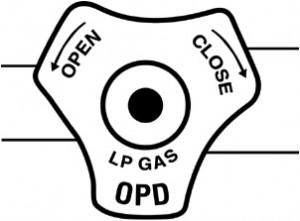BACKGROUND: Burning piled slash in the fall and spring is a standard silvicultural practice in the Northwest. One method of burning involves hand lighting slash piles. On a warm fall day at an Inland West location, a forester had ridden an all-terrain-vehicle to an area inaccessible by pick-up and was igniting slash piles with a hand-held torch.
PERSONAL CHARACTERISTICS: The forester had ten years’ experience and had burned piles many times in the past. He was considered fully trained.
NEAR MISS: Earlier that morning he had attached the torch to a two-gallon propane tank that was slightly overfilled. The forester set the propane tank down and was igniting a pile of slash when the torch passed close to the tank. The tank was venting propane that ignited. The forester, fearing an explosion, left the tank on the ground and ran 150 feet to the ATV only to find there was no fire extinguisher. He grabbed his coat from the ATV, ran back to the burning tank and smothered the fire. He could have been burned attempting to put out the fire. Overfilled propane tanks sometimes explode, resulting in severe injuries.
CAUSE OF NEAR MISS: To allow for expansion, propane tanks should not be filled beyond 80 percent capacity. In this case, the fittings had been properly installed and were tight, but the overfilled tank was venting through a bleeder valve. The forester had not tested the fittings for leaks and was unaware of the venting condition (it may not have been venting at the time the fittings were connected).
RECOMMENDATIONS FOR CORRECTION:
- The propane industry is retrofitting tanks with a new-style valve (Overfill Protection Device, or “OPD”) designed to prevent overfilling. New regulations require that OPD’s be installed on all propane tanks at the time of tank recertification, or no later than March 31, 2002. OPD’s are available and should be installed on tanks as they are refilled. These devices are easily identified by the valve handle, which is triangle-shaped (old-style valve handles are round) and carry the letters “OPD” (see figure).
- When filling a propane tank, ensure it is not filled beyond 80 percent of its capacity. Don’t count on possibly inexperienced service station attendants to know and follow safety precautions.
- When attaching fittings to propane tanks, check for leaks by listening, smelling, and applying soapy water to the fittings.
- Always have a fire extinguisher available during burning tasks. Attempting to put out a fire with a blanket, coat, or similar device can be dangerous.
 Courtesy of the Forest Resources Association: https://www.forestresources.org/
Courtesy of the Forest Resources Association: https://www.forestresources.org/
